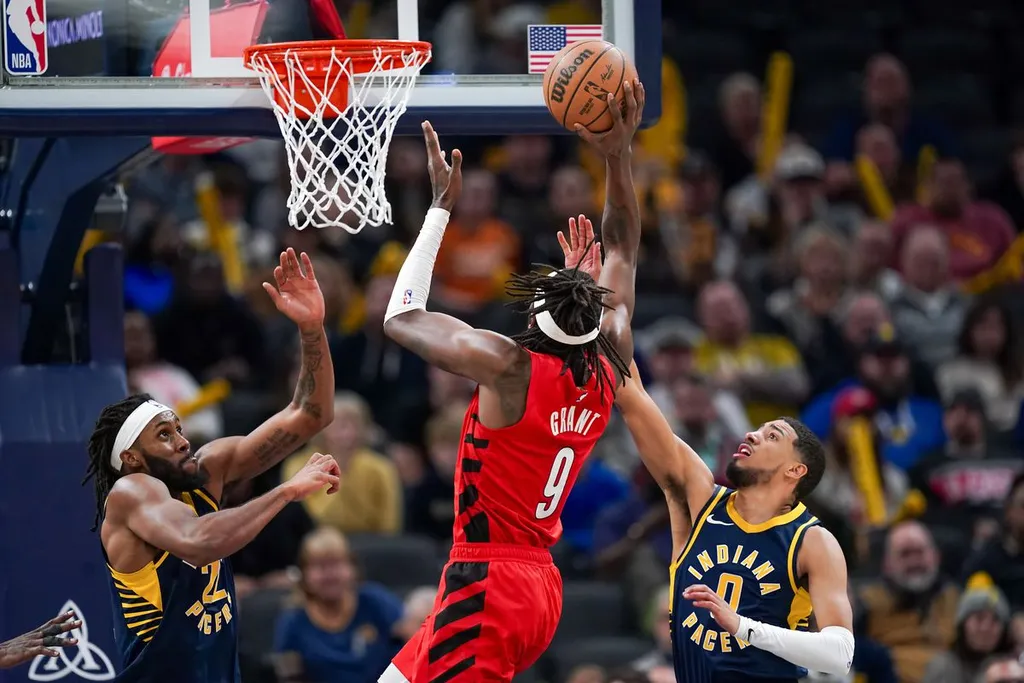Basketball fans around the world eagerly anticipate the NBA’s annual schedule release. The 2025-2026 season promises thrilling matchups, intense rivalries, and a full slate of events designed to keep fans on the edge of their seats. While exact game dates will be finalized closer to the season, here is a detailed breakdown of the key phases and events to look forward to.
The Breakdown: Key Phases and Dates
The NBA calendar is packed with exciting action from the preseason to the crowning of the league champion in the Finals. Below is a table summarizing the anticipated schedule:
| Phase | Dates | Details |
|---|---|---|
| Preseason | October 1-20, 2025 | Includes warm-up games, with notable games in Macao (Brooklyn Nets vs. Phoenix Suns). |
| Regular Season Start | October 21, 2025 | Opening night featuring marquee matchups. |
| Regular Season | October 2025 – April 2026 | Each team plays 82 games (41 home, 41 away). |
| Christmas Day Games | December 25, 2025 | Features high-profile matchups showcasing star players and rivalries. |
| NBA All-Star Weekend | February 13-15, 2026 | Includes the All-Star Game, Skills Challenge, and 3-Point Contest (Los Angeles, California). |
| Regular Season End | Early April 2026 | Final games to determine playoff seeds and play-in tournament contenders. |
| Play-In Tournament | Mid-April 2026 | Teams ranked 7th-10th in each conference compete for playoff spots. |
| NBA Playoffs | Mid-April – May 2026 | Best-of-seven series across four rounds (First Round, Semifinals, Conference Finals, Finals). |
| NBA Finals | June 2026 | Best-of-seven series to determine the league champion. |

Highlights to Watch For:
Preseason Action in Macao The Brooklyn Nets and Phoenix Suns are set to showcase their talents in Macao, giving international fans a chance to see their favorite stars up close. These games are a key part of the NBA’s global outreach.
Opening Night Excitement The regular season kicks off on October 21, 2025, with exciting matchups that often feature top contenders or intense rivalries.
Christmas Day Spectacle Christmas Day games are a fan-favorite tradition, offering high-profile matchups and memorable performances.
All-Star Weekend in Los Angeles The league’s brightest stars gather for a weekend of fun and competition in Los Angeles, California. This is an opportunity to celebrate the game’s top players and emerging talents.
Play-In Drama Introduced in recent years, the play-in tournament adds an extra layer of excitement by giving lower-seeded teams a shot at the playoffs.
The Road to the Finals The playoffs feature intense competition as teams battle for the championship. The Finals, scheduled for June 2026, promise to deliver unforgettable moments.
Stay Updated
As the season approaches, keep an eye on the NBA’s official website for the latest updates and detailed game schedules. Whether you’re a die-hard fan or a casual viewer, the 2025-2026 NBA season has something for everyone. Get ready to cheer for your favorite team and enjoy another thrilling year of basketball!
NBA Schedule FAQ's
Why does NBA schedule back to back games?
The NBA schedule includes back-to-back games (playing two games on consecutive days) for several reasons, with both advantages and disadvantages to consider:
Advantages:
- Efficiency: Scheduling back-to-backs allows the league to fit 82 games into a shorter timeframe, making the season more efficient and minimizing time gaps between games.
- Reduced Travel Costs: Playing both games in the same city eliminates the need for additional travel and minimizes associated costs for teams and the league.
- Fan Convenience: Back-to-backs in the same city provide fans with the opportunity to see multiple games within a short period, potentially boosting local ticket sales and fan engagement.
- TV Scheduling: Back-to-backs can accommodate national television contracts and offer broadcasters more doubleheaders with high-profile teams.
Disadvantages:
- Player Fatigue: Back-to-backs significantly increase the physical and mental strain on players, raising injury risks and potentially impacting performance.
- Competitive Imbalance: Playing on consecutive nights can disadvantage certain teams, especially for those facing back-to-back road trips or teams with less depth.
- Travel Logistics: Even within the same city, back-to-backs can still require travel between practice facilities and hotels, adding logistical challenges.
- Reduced Recovery Time: Back-to-backs limit opportunities for proper rest, recovery, and film study, potentially affecting team cohesion and preparation.
Minimizing Negatives:
The NBA acknowledges the downsides of back-to-backs and implements measures to mitigate them:
- Scheduling: Back-to-backs are spread out throughout the season to avoid overburdening teams.
- Travel Considerations: The league tries to limit back-to-backs, especially involving long travel distances.
- Player Rest: Teams may adjust rotations and playing time for key players during back-to-backs.
Conclusion:
While back-to-back games bring efficiency and other benefits, they also come with drawbacks, particularly for player well-being and competitive balance. The NBA navigates these complexities to find a balance between these factors, striving for a schedule that optimizes both entertainment and fair competition.
Is there NBA every night?
No, there isn’t NBA every night. While the NBA season itself can be quite long, typically spanning from October to June, not every day features games. Here’s a breakdown:
During the regular season:
- The NBA typically sees 4-5 games per day, scheduled strategically across different time zones to cater to a global audience. However, not every day has games – rest days are factored in for teams throughout the season.
- Games typically occur:
- Tuesdays and Thursdays: Doubleheaders with two games
- Wednesdays and Fridays: Doubleheaders with two games
- Saturdays and Sundays: Usually one game (early afternoon or primetime)
- Mondays: Occasional games, often featuring teams that haven’t played in several days
Outside the regular season:
- Preseason: Usually consists of exhibition games, with a lighter schedule compared to the regular season.
- Playoffs: A series of elimination rounds with fewer games per day compared to the regular season.
- Offseason: No official games take place during this period.
Ultimately, while the NBA season spans several months, individual teams and the league itself have rest periods, resulting in days without games. You can follow the official NBA schedule on their website to see which days feature exciting matchups: https://www.nba.com/schedule
Do NBA teams play 3 nights in a row?
It’s very uncommon for NBA teams to play three nights in a row. The NBA schedule is carefully constructed to avoid such demanding stretches for players, considering:
- Player fatigue: Three games in three nights take a significant toll on players’ physical and mental well-being, increasing injury risk and potentially impacting performance.
- Travel considerations: Back-to-back games often involve travel between cities, adding another layer of fatigue and logistical challenges.
- Competitive balance: Playing three games in a row could disadvantage a team compared to others with more rest throughout the season.
While technically possible, instances of three consecutive games are rare and usually arise due to scheduling conflicts or unusual circumstances. The league prioritizes fair competition and player health, avoiding such demanding stretches whenever possible.
Here are some alternative scenarios that might appear like three games in a row:
- Back-to-back games: Teams often play two consecutive games, usually in different cities, with a day off in between. This is considered the maximum consecutive workload under normal circumstances.
- Three games in four nights: Sometimes, a team might have a game, followed by a day off, then another game, and another day off before a third game. While not technically three in a row, this can still be physically demanding.
Overall, you can expect NBA teams to have at least one day off between games, ensuring optimal performance and player well-being throughout the season.
What month does NBA end?
The NBA season typically ends in June, marking the culmination of the playoffs and crowning the championship team. Here’s a breakdown of the timeline:
October: The regular season usually starts around the second week of October. Preseason exhibition games might occur earlier in the month. April: The regular season concludes in mid-April. April – June: The playoffs take place, featuring series of elimination rounds culminating in the NBA Finals between the Eastern and Western Conference champions. The Finals typically stretch into June.
Therefore, while there may be slight variations year-to-year depending on scheduling, you can confidently say that the NBA season ends in June.
What months are NBA basketball season?
The NBA basketball season typically runs from October to June, encompassing both the regular season and playoffs. Here’s a breakdown:
- October: The regular season usually starts around the second week of October. Preseason exhibition games may occur earlier in the month.
- November – April: This period comprises the majority of the regular season, with teams playing 82 games each.
- April: The regular season concludes in mid-April.
- April – June: The playoffs take place, featuring a series of elimination rounds culminating in the NBA Finals between the Eastern and Western Conference champions. The Finals typically stretch into June.
So, while there may be some slight variations year-to-year depending on scheduling, you can expect NBA action most months from October through June.
What is the NBA schedule format?
The NBA schedule format combines aspects of fixed and flexible scheduling to ensure every team plays each other a fair number of times while adhering to logistical constraints. Here’s a breakdown:
Fixed Schedule:
- Division Games: Each team plays its four divisional rivals four times (16 games total). This fosters intense rivalries and familiarity.
- Interconference Games: Each team plays six teams from the opposite conference twice (12 games total). This ensures exposure to different playing styles and expands fan interest.
Flexible Schedule:
- Remaining Interconference Games: Each team plays the remaining four teams from the opposite conference three times (12 games total). This ensures all teams play each other at least once during the regular season.
- Opponent Selection: Some remaining games are determined by a strength-of-schedule formula, ensuring fairer challenges based on team performance.
- Balanced Scheduling: The league strives to balance home and away games for each team and minimize back-to-back road trips.
Additional factors:
- National TV Games: Certain high-profile matchups are selected for national broadcasts, influencing scheduling slightly.
- Travel Considerations: Scheduling aims to minimize long and frequent travel stretches for teams.
- Rest Days: Days off are strategically placed between games to help player recovery.
Impact:
This format strives for:
- Competitiveness: Fair scheduling and division rivalries promote intense competition.
- Variety: Teams encounter different playing styles and matchups throughout the season.
- National Interest: High-profile games garner wider attention.
- Player Well-being: Scheduled rest days help prevent injuries and fatigue.
Remember, the specific formula and exact schedules are subject to change depending on the season and unforeseen circumstances.
How does NBA season work?
Here’s a breakdown of how the NBA season works:
Preseason (September-October):
- A short period of exhibition games (around 4-6 per team) where teams experiment with lineups, strategies, and new players.
- No impact on regular season standings.
Regular Season (October-April):
- Each team plays 82 games:
- 4 games against each divisional opponent (16 games)
- 3 games against 4 interconference opponents (12 games)
- 2 games against the remaining 6 interconference opponents (12 games)
- Games are scheduled to ensure a balance of home and away matchups and minimize back-to-back travel.
- Standings are based on win-loss record (wins are worth 2 points, losses 1).
- Top 10 teams from each conference (based on win-loss record) qualify for the playoffs.
Playoffs (April-June):
- A single-elimination tournament to determine the NBA champion.
- Each conference has its own playoff bracket:
- Play-in tournament for the final 2 playoff spots in each conference (if needed)
- First round: best-of-seven series
- Second round: best-of-seven series
- Conference Finals: best-of-seven series
- NBA Finals: best-of-seven series between Eastern and Western Conference champions
Key Events:
- All-Star Weekend (February): A showcase event featuring various competitions (skills challenge, three-point contest, slam dunk contest) and the All-Star Game, where Eastern and Western Conference All-Stars compete.
- Trade Deadline (February): Teams can trade players until this deadline to improve their rosters for the playoff push.
Additional notes:
- Injuries, trades, and unexpected events can significantly impact individual teams’ performances and playoff aspirations.
- The NBA constantly tweaks the schedule format and playoff rules to optimize fairness, fan engagement, and player well-being.
I hope this comprehensive explanation gives you a clear understanding of how the NBA season works!
Is the NBA schedule random?
While the NBA schedule isn’t entirely random, it’s not completely fixed either. It’s a hybrid format that combines different elements to achieve specific goals. Here’s a breakdown:
Fixed elements:
- Division Games: Each team plays their four divisional rivals four times per season, ensuring strong rivalries and familiarity.
- Interconference Games: A minimum number of matchups are predetermined, ensuring exposure to different playing styles and fan interest.
Flexible elements:
- Remaining Interconference Games: Teams play the remaining interconference opponents a varying number of times based on a strength-of-schedule formula, striving for competitive balance.
- Opponent Selection: Some games are selected through a draft where teams prioritize desired matchups.
- Balanced Scheduling: Efforts are made to distribute home and away games evenly and minimize back-to-back travel.
Therefore, it’s not random in the sense that:
- Specific divisional and interconference matchups are predetermined.
- Certain factors like travel and national TV appearances influence scheduling.
- The league aims for competitive balance through strength-of-schedule adjustments.
However, it does have some random elements:
- The specific opponents chosen in the draft.
- The exact order of games within the season.
- Unforeseen circumstances like injuries or trades can shake things up.
Ultimately, the NBA schedule aims for a balance between fixed structures that guarantee certain matchups and flexibility for competitive balance, travel considerations, and national TV interest. While not entirely random, it’s not rigidly predetermined either.



